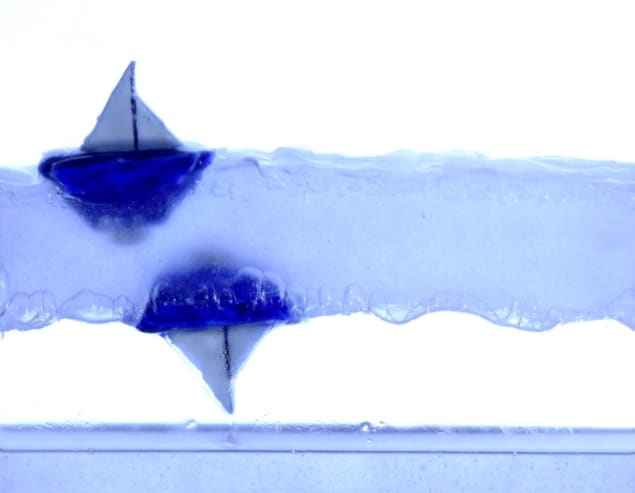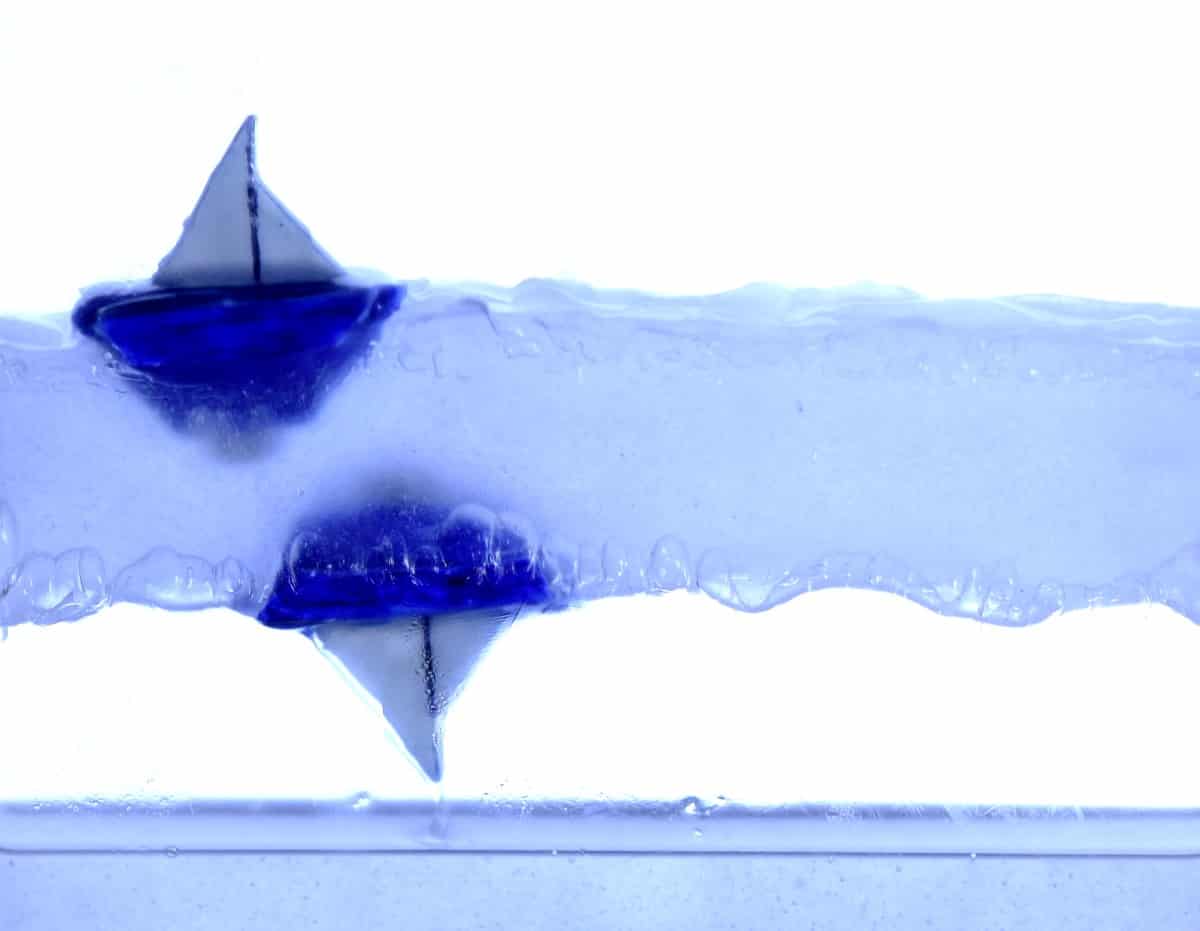
Physicists in France have made small objects float upside-down on the underside of a layer of viscous liquid levitating in air. Although their apparently gravity-defying demonstration breaks no laws of physics, they say it could shed new light on the interaction between air and liquids.
Archimedes’ principle says that an object fully or partially immersed in a liquid experiences the upward force of buoyancy, which is equal to the weight of liquid it displaces. By opposing the force of gravity due to the object’s own weight, buoyancy will cause an object to float if it is less dense (overall) than the liquid – while denser objects will sink.
This is a very familiar phenomenon in our everyday world in which water and other liquids naturally exist at a lower gravitational potential than less dense gases. People on a boat travel through the air, with the sea below them. What the latest research shows is that the same principle would hold for people in an upside-down world – one in which, in effect, the sky lies beneath the sea.
Counter-intuitive effects
The secret to bringing about this topsy-turvy floating is vibration. Since the 1950s, scientists have demonstrated a range of counter-intuitive effects by vibrating fluids at high frequencies. Gas bubbles, for example, can be made to sink, while heavier particles rise. On a larger scale, whole layers of fluid can levitate in air. This is because more dense fluids tend to drip under the action of gravity, eventually displacing the air beneath them. By preventing the formation of drops, vibration keeps the fluid’s lower surface flat and allows it to hover.
In the new experiment, Emmanuel Fort and colleagues at the PSL University in Paris fixed a plexiglass container to a vibrating platform and then filled the container with either silicon oil or glycerol. These viscous liquids have surfaces that remain stable even at high accelerations. After turning the shaker on, the researchers used a syringe with a long needle to inject air towards the bottom of the liquid. With the resulting bubble sinking and growing, it eventually created a layer of air across the bottom of the container – causing the viscous liquid to levitate.
This fluid levitation is nothing new, but what Fort and co-workers then did was to place objects upside-down on the lower interface between the liquid and the air. As they explain in a paper in Nature, this buoyancy is governed by the same basic physics that would be at work on the upper interface. The object’s gravity tending to pull it down while the disturbance its downward motion creates in the liquid tends to pull it up.
Slight displacement from equilibrium
There is an important difference between the normal and inverted flotation, however. In the former, an object is in stable equilibrium because any attempt to move it up or down will be met by a restoring force. When pushed down it displaces a greater amount of liquid and so experiences more buoyancy, while any force pushing it out of the liquid will be opposed by gravity. But in the upside-down case, any slight displacement from equilibrium will see the object accelerate away – thanks to gravity below and the mass of liquid above.
Fort and colleagues found that the vibrations needed to invert the air and liquid also in fact stabilized the exotic buoyancy – at least for objects up to a certain density. They vibrated the container at 100 Hz and showed they could pin a series of small plastic spheres to the lower liquid-air interface, with the spheres remaining in place even when they poked them. To make the demonstration more eye-catching they repeated the feat with a little plastic boat, while floating an identical boat on the upper interface (see figure).
The researchers then found that 2.5 cm-diameter plastic spheres weighing no more than about 6 g only fell to the bottom of the chamber once they had reduced the amplitude of the vibrations to the point where the liquid layer itself succumbed to gravity. Heavier spheres, in contrast, fell first. This behaviour, they say, is consistent with a simple theoretical model that they developed to explain the inverted buoyancy. Only when the spheres’ density approached that of the liquid – meaning a mass of about 8 g – did significant discrepancies occur. In that case, they add, other more complex effects play a role.

Fluids only get so runny as physicists put a universal lower limit on viscosity
The team based its model on the concept of time-averaged forces, which tend to stabilize the equilibrium states. As they point out, this is the same basic idea underlying what is known as a Stephenson–Kapitza pendulum. In that case, vibrations allow a pendulum fixed from below to oscillate back and forth in a small arc – when otherwise it would fall to the ground.
Writing a commentary piece in Nature, Vladislav Sorokin of the University of Auckland in New Zealand and Iliya Blekhman of the Russian Academy of Science in St Petersburg, Russia, argue that several assumptions – such as a linear relationship between the pressure and height of the air layer – “somewhat limit the accuracy” of the French group’s model. But they reckon that the work might nevertheless lead to practical applications – pointing out that gravity-defying effects in fluids have previously been used to improve chemical reactions and aid mineral processing – and that it suggests other “remarkable phenomena” remain to be discovered in vibrating mechanical systems.
